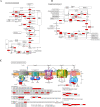Global analysis of lysine 2-hydroxyisobutyrylation in wheat root
- PMID: 33737719
- PMCID: PMC7973580
- DOI: 10.1038/s41598-021-85879-y
Global analysis of lysine 2-hydroxyisobutyrylation in wheat root
Abstract
Lysine 2-hydroxyisobutyrylation (Khib) is a novel naturally occurring post-translational modification. The system Khib identification at proteomics level has been performed in various species and tissues to characterize the role of Khib in biological activities. However, the study of Khib in plant species is relatively less. In the present study, the first plant root tissues lysine 2-hydroxyisobutyrylome analysis was performed in wheat with antibody immunoprecipitation affinity, high resolution mass spectrometry-based proteomics and bioinformatics analysis. In total, 6328 Khib sites in 2186 proteins were repeatedly identified in three replicates. These Khib proteins showed a wide subcellular location distribution. Function and pathways characterization of these Khib proteins indicated that many cellular functions and metabolism pathways were potentially affected by this modification. Protein and amino acid metabolism related process may be regulated by Khib, especially ribosome activities and proteins biosynthesis process. Carbohydrate metabolism and energy production related processes including glycolysis/gluconeogenesis, TCA cycle and oxidative phosphorylation pathways were also affected by Khib modification. Besides, root sulfur assimilation and transformation related enzymes exhibited Khib modification. Our work illustrated the potential regulation role of Khib in wheat root physiology and biology, which could be used as a useful reference for Khib study in plant root.
Conflict of interest statement
The authors declare no competing interests.
Figures






Similar articles
-
Systematic analysis of lysine 2-hydroxyisobutyrylation posttranslational modification in wheat leaves.PLoS One. 2021 Jun 17;16(6):e0253325. doi: 10.1371/journal.pone.0253325. eCollection 2021. PLoS One. 2021. PMID: 34138952 Free PMC article.
-
Proteome-wide identification of lysine 2-hydroxyisobutyrylation reveals conserved and novel histone modifications in Physcomitrella patens.Sci Rep. 2017 Nov 14;7(1):15553. doi: 10.1038/s41598-017-15854-z. Sci Rep. 2017. PMID: 29138512 Free PMC article.
-
Global Profiling of 2-hydroxyisobutyrylome in Common Wheat.Genomics Proteomics Bioinformatics. 2022 Aug;20(4):688-701. doi: 10.1016/j.gpb.2020.06.008. Epub 2021 Feb 11. Genomics Proteomics Bioinformatics. 2022. PMID: 33581340 Free PMC article.
-
Metabolic Functions of Lysine 2-Hydroxyisobutyrylation.Cureus. 2020 Aug 11;12(8):e9651. doi: 10.7759/cureus.9651. Cureus. 2020. PMID: 32923251 Free PMC article. Review.
-
Research advances in protein lysine 2-hydroxyisobutyrylation: From mechanistic regulation to disease relevance.J Cell Physiol. 2024 Dec;239(12):e31435. doi: 10.1002/jcp.31435. Epub 2024 Oct 1. J Cell Physiol. 2024. PMID: 39351825 Review.
Cited by
-
Proteomic analysis of protein lysine 2-hydroxyisobutyrylation (Khib) in soybean leaves.BMC Plant Biol. 2023 Jan 12;23(1):23. doi: 10.1186/s12870-022-04033-6. BMC Plant Biol. 2023. PMID: 36631736 Free PMC article.
-
Proteome-Wide Analysis of Lysine 2-Hydroxyisobutyrylation in Aspergillus niger in Peanuts.Front Microbiol. 2021 Aug 18;12:719337. doi: 10.3389/fmicb.2021.719337. eCollection 2021. Front Microbiol. 2021. PMID: 34489910 Free PMC article.
-
Crop Proteomics under Abiotic Stress: From Data to Insights.Plants (Basel). 2022 Oct 27;11(21):2877. doi: 10.3390/plants11212877. Plants (Basel). 2022. PMID: 36365330 Free PMC article. Review.
-
Global analysis of lysine 2-hydroxyisobutyrylation during Fusarium graminearum infection in maize.Front Plant Sci. 2022 Sep 15;13:1000039. doi: 10.3389/fpls.2022.1000039. eCollection 2022. Front Plant Sci. 2022. PMID: 36186065 Free PMC article.
-
Lactate and Lactylation in Sepsis: A Comprehensive Review.J Inflamm Res. 2024 Jul 8;17:4405-4417. doi: 10.2147/JIR.S459185. eCollection 2024. J Inflamm Res. 2024. PMID: 39006496 Free PMC article. Review.
References
-
- Wang Y, Zhang J, Li B, He QY. Advances of proteomics in novel PTM discovery: Applications in cancer therapy. Small Methods. 2019;4:23. doi: 10.1002/smtd.201900041. - DOI
Publication types
MeSH terms
Substances
LinkOut - more resources
Full Text Sources
Other Literature Sources
Molecular Biology Databases

